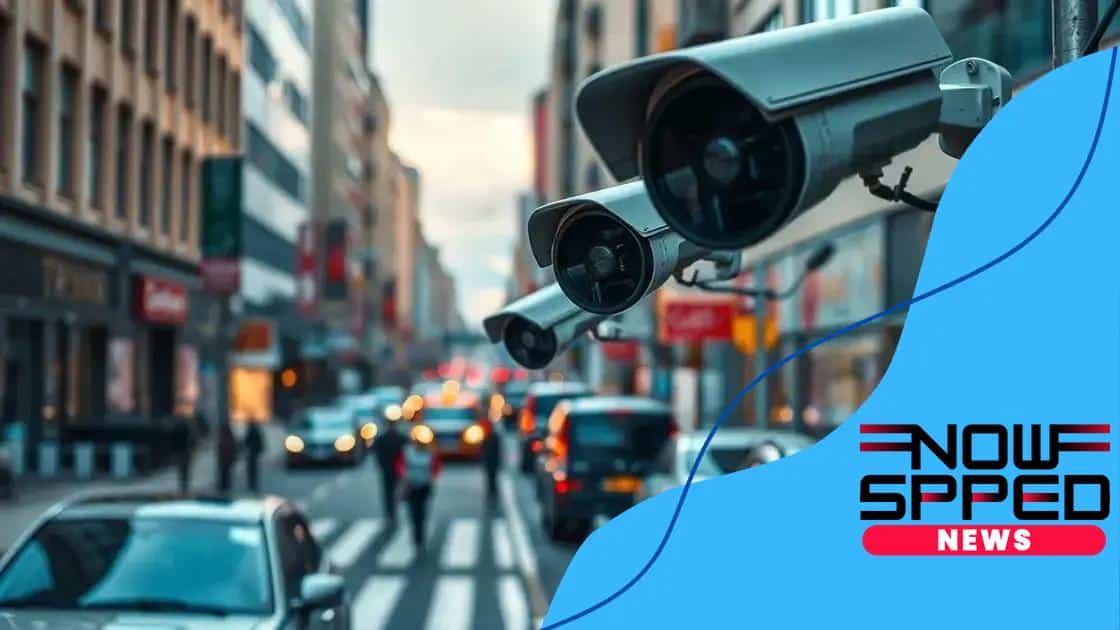The role of facial recognition in enhancing public safety

The role of facial recognition in enhancing public safety involves quick suspect identification, crime prevention, and improved security measures, while also raising concerns about privacy, ethical use, and system accuracy.
The role of facial recognition in enhancing public safety has become a significant conversation in our increasingly digital world. With advancements in technology, how does this tool reshape our security approaches?
Understanding facial recognition technology
Understanding facial recognition technology is essential in grasping how it impacts public safety today. This technology uses algorithms to analyze facial features in images or videos. By recognizing unique patterns, it matches faces with databases, helping authorities identify individuals quickly.
The fundamentals of how it works
Facial recognition systems employ different techniques to detect and interpret faces. They capture images and convert them into data points that represent features like the distance between eyes or the shape of the jawline. This information is then compared to existing data for identification.
Key components of facial recognition
- Face detection: Identifying and locating a face in an image.
- Feature extraction: Analyzing face shapes and features to create a biometric template.
- Face matching: Comparing the template against stored images in a database.
- Decision making: Determining the likelihood of a match and providing results.
With advancements in artificial intelligence, the accuracy of these systems has improved significantly. Now, they can work in various lighting conditions and at different angles, which enhances their effectiveness in real-world applications. Law enforcement agencies often use this technology to identify suspects in criminal investigations and track down missing persons.
However, while the benefits are clear, there are concerns about privacy and potential misuse. The ethics of surveillance technology has sparked debates about the balance between security and personal freedom. Citizens often grapple with the idea that their faces might be analyzed without consent, raising questions about the limits of monitoring.
In summary, understanding facial recognition technology helps illuminate its role in enhancing public safety. As it becomes more integrated into our daily lives, ongoing discussions about its implications will be crucial.
Benefits of facial recognition for public safety
Benefits of facial recognition for public safety have become increasingly evident as this technology evolves. It offers a range of advantages that enhance security measures in various environments, from public spaces to private properties.
Quick identification of suspects
One primary benefit is the ability to quickly identify and apprehend suspects. Whenever a crime occurs, law enforcement can utilize facial recognition to scan surveillance footage. This expedites the process of locating suspects, potentially preventing further harm.
Preventing crime
Another significant benefit is crime prevention. The presence of facial recognition technology often deters individuals from committing crimes in monitored areas. When people know they can be identified, they may think twice before engaging in illegal activities.
- Deterrence: Increased security leads to a decrease in potential criminal behavior.
- Rapid response: Authorities can react quickly to ongoing incidents.
- Enhanced investigations: Facial recognition aids investigations by providing leads.
- Community safety: Increases overall public safety perception.
Moreover, this technology can aid in locating missing persons. By analyzing facial features from missing person reports alongside public footage, authorities can find individuals who may be lost or in danger. This capability showcases how the technology not only helps in criminal cases but also assists within the community.
Additionally, facial recognition can enhance access control. In schools, airports, and other secure areas, it can ensure that only authorized individuals enter sensitive locations. This increases safety for students, travelers, and employees alike.
In conclusion, the benefits of facial recognition for public safety are substantial, from quick identification to crime prevention and enhanced community security. As the technology continues to mature, its application could play a crucial role in how we maintain safety in our everyday lives.
Challenges in implementing facial recognition

Challenges in implementing facial recognition technology are significant and complex. Despite its advantages, several factors complicate its deployment in public safety systems.
Privacy concerns
One of the foremost challenges is the issue of privacy. Many individuals feel uncomfortable with their faces being monitored and analyzed without consent. This can lead to public backlash against the use of facial recognition, prompting calls for stricter regulations on surveillance.
Accuracy and bias
Another critical challenge involves the accuracy of facial recognition systems. These systems can sometimes misidentify individuals, especially among diverse populations. If the technology is biased, it could lead to wrongful accusations or discrimination.
- False positives: Incorrectly matching innocent people to criminal databases.
- Varying effectiveness: The technology can struggle with different skin tones and ages.
- Data quality: Poor image quality can impact recognition accuracy.
- Algorithm transparency: Many systems operate as “black boxes,” limiting understanding of their processes.
Moreover, there are technical limitations that must be addressed. For example, different lighting conditions and angles can affect a system’s ability to recognize faces accurately. This inconsistency complicates reliable performance in real-world scenarios.
Legal frameworks and regulations also present hurdles. Each jurisdiction may have different laws regarding data usage and privacy, making it difficult to deploy a uniform system across regions. Organizations must navigate these legal landscapes carefully to avoid penalties.
Finally, public perception plays a crucial role in the implementation process. If the community does not trust how the technology is used, they may oppose or resist its integration into public safety measures.
Ethical considerations of surveillance
Ethical considerations of surveillance technology, especially in facial recognition, have sparked significant debate. As this technology becomes more prevalent, it’s crucial to examine the moral implications of monitoring individuals in public spaces.
Privacy rights
The foundational ethical concern revolves around individual privacy rights. Many argue that constant surveillance infringes on the freedom to move without being observed. People should have control over how their personal information, including their faces, is used.
Informed consent
Another critical ethical issue is the concept of informed consent. In many cases, individuals do not explicitly agree to have their images captured and analyzed. This raises questions about the legality and morality of using facial recognition without prior notice.
- Surveillance transparency: Authorities should inform the public about surveillance practices.
- Data usage: Clear guidelines need to govern how biometric data is collected and stored.
- Accountability: There should be mechanisms in place to hold parties accountable for misuse of the technology.
- Public trust: Building trust is essential for acceptance.
Furthermore, there is a risk of bias and discrimination in surveillance practices. Studies have shown that racial and ethnic minorities may be disproportionately affected by facial recognition technology. This raises ethical concerns about fairness and equality in law enforcement and surveillance.
Moreover, the potential for abuse of surveillance data is alarming. When placed in the wrong hands, this information can lead to harassment, stalking, or wrongful arrests. Ethical considerations must include safeguards to prevent harm to individuals.
Additionally, the balance between security and civil liberties is a continuing concern. Effective measures must be employed to ensure that the pursuit of safety does not come at the expense of individual rights.
Future trends in facial recognition
Future trends in facial recognition are poised to reshape how this technology is utilized for public safety and security. As advancements continue, several trends are emerging that will enhance the effectiveness and reliability of facial recognition systems.
Increased accuracy with AI
One major trend is the integration of advanced artificial intelligence (AI) algorithms. These algorithms improve the accuracy of facial recognition systems, minimizing errors and false positives. The development of machine learning enables systems to learn from data, making them smarter over time.
Real-time processing capabilities
Another exciting trend is the enhancement of real-time processing capabilities. With improved technology, facial recognition can analyze and identify faces instantly. This is crucial in emergency situations where quick decisions are needed.
- Enhanced security: Faster identification can lead to quicker responses to potential threats.
- Broader applications: From airports to shopping malls, technology can be used for crowd management.
- Better user experience: Seamless integration in daily activities can improve convenience.
- Increased public safety: A timely response can help prevent crime and keep communities safe.
Moreover, privacy-preserving technologies will play a vital role in the future. There is a growing demand for solutions that balance safety with individual privacy rights. Innovations like decentralized facial recognition systems may allow effective monitoring while protecting personal data.
Ethical designs are likely to be a priority as well. Developers will need to focus on creating transparent systems, minimizing biases, and encouraging public trust. The community’s perspective will shape how new technologies are implemented, ensuring the focus remains on public benefit.
From law enforcement to personal devices, the potential applications of facial recognition will continue to expand. We may see more uses in various sectors, such as healthcare for patient identification or in retail for personalized shopping experiences.
FAQ – Frequently Asked Questions about Facial Recognition Technology
What are the benefits of facial recognition for public safety?
Facial recognition enhances security by quickly identifying suspects and can help prevent crime, making public spaces safer.
What challenges does facial recognition technology face?
Challenges include privacy concerns, potential biases in the system, and accuracy issues that may lead to misidentification.
How does ethical consideration impact facial recognition use?
Ethical considerations focus on balancing privacy rights with security needs, ensuring transparency and fairness in technology deployment.
What future trends can we expect in facial recognition technology?
Future trends include increased integration of AI, real-time processing capabilities, and a focus on privacy-preserving solutions.





